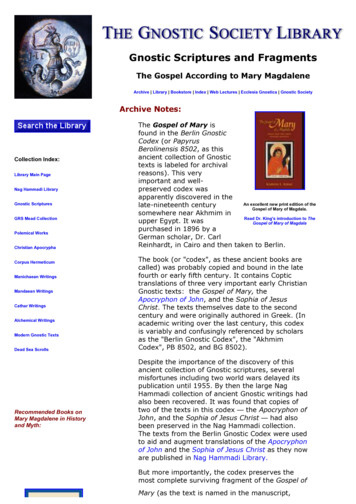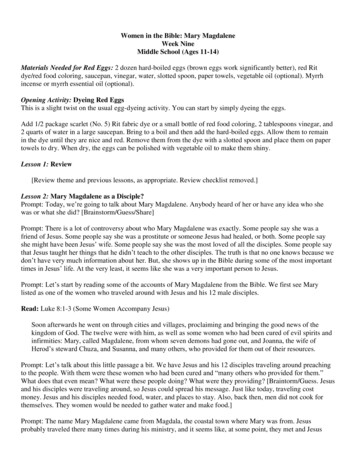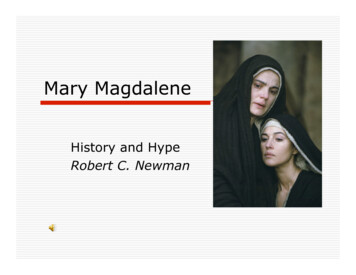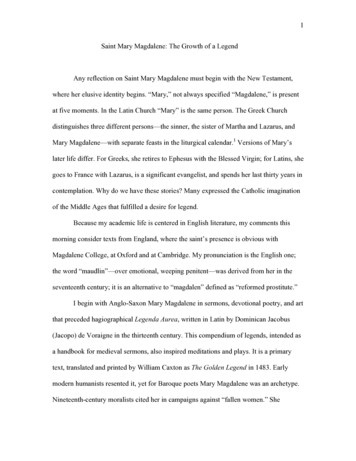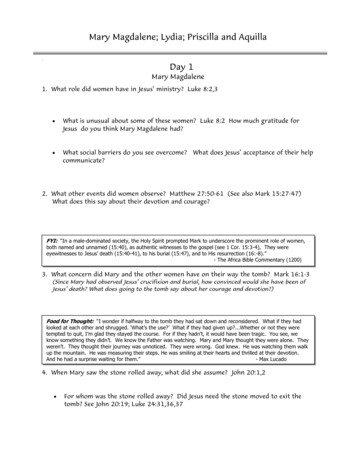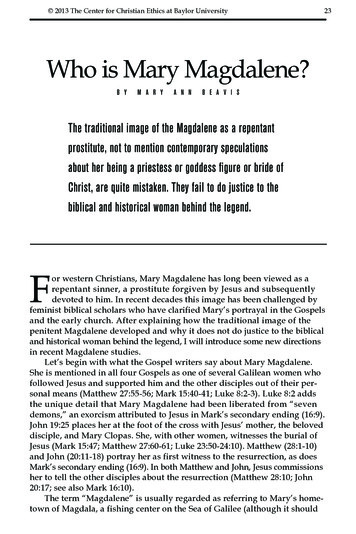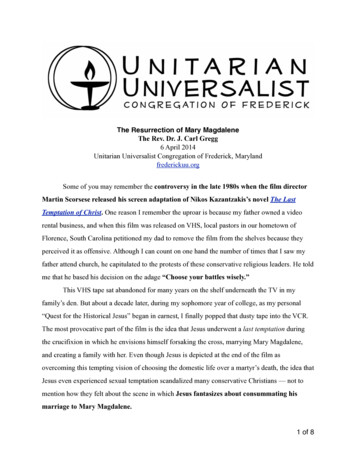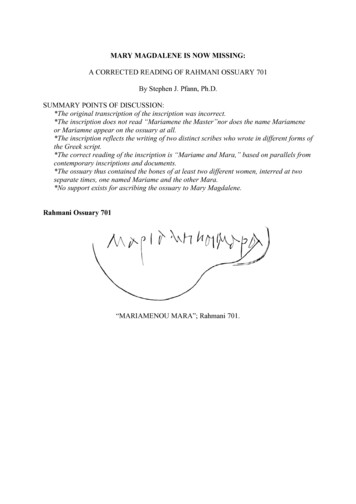
Transcription
HOW MARY MAGDALENEWAS MADE WELL
Copyright 2018 by Kate MooreheadAll rights reserved. No part of this book may be reproduced, stored in a retrievalsystem, or transmitted in any form or by any means, electronic or mechanical,including photocopying, recording, or otherwise, without the written permission of the publisher.Unless otherwise noted, the scripture quotations contained herein are fromthe New Revised Standard Version Bible, copyright 1989 by the Divisionof Christian Education of the National Council of Churches of Christ in theU.S.A. Used by permission. All rights reserved.Church Publishing19 East 34th StreetNew York, NY 10016www.churchpublishing.orgCover art: Robert Garrigus / Alamy Stock PhotoCover design by Jennifer Kopec, 2Pug DesignTypeset by Rose DesignLibrary of Congress Cataloging-in-Publication DataNames: Moorehead, Kate, 1970– author.Title: Healed : how Mary Magdelene was made well / Kate Moorehead.Description: New York : Church Publishing, 2018.Identifiers: LCCN 2017036398 (print) LCCN 2017048685 (ebook) ISBN9780898690712 (ebook) ISBN 9780898690705 (pbk.)Subjects: LCSH: Mary Magdalene, Saint. cation: LCC BS2485 (ebook) LCC BS2485 .M66 2018 (print) DDC226/.092—dc23LC record available at https://lccn.loc.gov/2017036398Printed in the United States of America
ContentsIntroduction . . . . . . . . . . . . . . . . . . . . . . . . . . . . . . . . . . . . . . . . . v1. Making a Woman . . . . . . . . . . . . . . . . . . . . . . . . . . . . . . . . 12. Sex on the Brain . . . . . . . . . . . . . . . . . . . . . . . . . . . . . . . 163. The Real Mary . . . . . . . . . . . . . . . . . . . . . . . . . . . . . . . . . 244. Demons . . . . . . . . . . . . . . . . . . . . . . . . . . . . . . . . . . . . . . 335. Saintly Struggles . . . . . . . . . . . . . . . . . . . . . . . . . . . . . . . 426. Tempted . . . . . . . . . . . . . . . . . . . . . . . . . . . . . . . . . . . . . 537. The Providers . . . . . . . . . . . . . . . . . . . . . . . . . . . . . . . . . 638. Being There . . . . . . . . . . . . . . . . . . . . . . . . . . . . . . . . . . . 709. Essential Rest . . . . . . . . . . . . . . . . . . . . . . . . . . . . . . . . . 7710. Coming to the Tomb . . . . . . . . . . . . . . . . . . . . . . . . . . . . 801 1 . Breaking Open . . . . . . . . . . . . . . . . . . . . . . . . . . . . . . . . 8512. Encountering Angels . . . . . . . . . . . . . . . . . . . . . . . . . . . 9113. The Conversation . . . . . . . . . . . . . . . . . . . . . . . . . . . . . . 9714. The First Preacher . . . . . . . . . . . . . . . . . . . . . . . . . . . . 10515. Mary’s Silence . . . . . . . . . . . . . . . . . . . . . . . . . . . . . . . . 11016. Learning from Mary . . . . . . . . . . . . . . . . . . . . . . . . . . . 116
1Making a WomanIwas the first woman to lead all three of the churches that Ihave served. I don’t know if my leadership is supposed to lookdifferent than a man’s. My husband used to pump me up whenI first came to St. John’s Cathedral. “Be the Dean!” he wouldsay. I would try not to slouch. I would try to sound confidentand tough. But really, I didn’t know what I was supposed to bedoing. I have been like a blind person groping my way towardssome uniquely feminine form of leadership. To tell you thetruth, I often didn’t think much about it until I started doingretreats for women and they began asking me about what it waslike to be a woman leader in the church.I found myself searching the Bible for answers to their questions about what it meant to be a woman leader. Did womenfollow Jesus differently? How did they interact with Jesus? Howdid they worship him? Was there something that I was supposedto be doing?Mary Magdalene and Mary the mother of Jesus were themost important women in Jesus’s life. One is inaccuratelyknown as a repentant prostitute, the other as a perpetual virgin.1
2HealedThese women are defined by whether or not they had sex. Butwho were they to Jes ring and wherewe live in harmony with God. A child is born expecting and, infact, deserving perfect care. And we parents, fallen creatures thatwe are, do our very best and still mess things up.We love fairy tales for good reason. The good and the badare so well differentiated. I love to take my boys to the movies5. Justin Martyr, Dialogue with Trypho, ch. 100, trans. Marcus Dods and George Reith, inAnte-Nicene Fathers, vol. 1.
10Healedand watch the good guys beat up the bad guys. We all want todefeat evil and live happily-ever-after just like they do in themovies. It is immensely satisfying to watch because it feels right.On some level, we still assume that life should be lived in astate of peace and joy. When I counsel young couples planningto be married, part of what I have to do is remind them thattheir lives will not be a happily-ever-after. No matter how goodthey are to each other, they will encounter pain and conflict.It is part of the fallen nature of our world. They will have tofight for their marriage. It will not be easy. And when things getdifficult, it will no doubt surprise them. They will think thatthey have done something wrong, but really it is human natureto struggle. We just don’t believe that things should be hard.Our yearning for peace, our yearning for happiness—theseare signs of the fact that we were created by God for Eden. Wewere designed to live in harmony with God. Eden is where welong to be; it is where things feel right. It is where we belongand we keep trying to get back there.Humanity has fallen from paradise; there is no denyingthat fact. But the fall of humanity—is it the fault of the womanalone? Does she alone bear full responsibility? The man choseto eat as well, but because the woman ate first, she is consideredthe more fallen of the two, the great temptress.Mary the Virgin and Mary Magdalene:The Two Extremes ContinueEchoes of Lilith and Eve were woven deeply into the Christiantradition. After Jesus’s death and resurrection, when the writers
Making a Woman11of the gospels began to tell the story, there arose two important women. One was Mary the mother of Jesus, the other wasMary Magdalene. In the gospels themselves, these women areportrayed with all the complexity and dimension of the men.Jesus’s mother gets afraid and impatient with her son. She eventries to accuse Jesus of being possessed by a demon in order tobring him home. Mary Magdalene is a woman who has beenhealed by Jesus and becomes one of his most faithful followers.Jesus’s relationships with both his mother and with Mary Magdalene seem to be relationships of mutual love and respect. Itis Jesus’s mother who urges him to perform his first miracle inthe Gospel of John and it is Mary Magdalene who first sees theRisen Christ.But as the centuries passed, these rich biblical charactersbegan to be painted in black and white. Mary the mother ofJesus is described as a virgin in the gospels of Matthew andLuke. She was not yet married when she became pregnant bythe Holy Spirit. Jesus did not have an earthly father, and Josephwaited until Jesus was born to have marital relations with hiswife. This is an important concept, for it validates the understanding that Jesus was born of God and of man. God was thefather, humanity the mother. Over the centuries, the churchbegan to believe that Jesus’s mother Mary never had sex at all inher entire lifetime. Mary was considered a perpetual virgin.The concept of Mary’s perpetual virginity began in the second century with both Irenaeus and Origen. By the fourth century, it was well established as a teaching of the church. Marywas viewed as the second Eve, and her purity—her total lackof sexual activity during the course of her lifetime—made her
12Healedthe antithesis of a temptress. John Chrysostom used the instruction of Jesus on the cross to his disciple—behold your son, beholdyour mother—as evidence of Mary’s perpetual virginity and thefact that Jesus was her only son. Augustine of Hippo argued forthe perpetual virginity of Mary, and Thomas Aquinas arguedthat to doubt the perpetual virginity of Mary was to call intoquestion the perfection of Christ and insult the dignity of theMother of God.In the year 553, Mary was declared a perpetual virgin bythe Second Council of Constantinople. The Bible tells us thatJoseph did not know his wife sexually “until she had borne ason” (Matthew 1:25). But this verse was overlooked. Thereare also passages that refer to Jesus’s brothers and sisters, butthese were translated using a secondary translation, as cousinsor friends. Even James, the brother of Jesus, was declared hiscousin.6 It seemed essential for the church to believe that Marythe Mother of Jesus never had sex. This is still considered anessential doctrine in the Roman Catholic tradition today.I have prayed to Mary myself. I find the concept of her perpetual virginity to be possible, even likely. Perhaps Mary, likeJesus, was so in love with God that she never had sex with herhusband. In other words, perhaps the love of God replaced allcarnal desire for both of them. I do not deny that this theory isentirely possible and would hold true with many of the saints ofthe church who simply refrained from sexual activity and were6. Another theory has Joseph marry another woman. This woman, called Melcha, bearshis other children and in this way, Jesus had brothers and sisters while his mother, Mary,remained a virgin all her life.
Making a Woman13consumed with the love of God. However, if Mary were to havesex with Joseph after the birth of Jesus, as the synoptic gospelswould suggest, this would not make her less of a pure woman inmy mind. To mother more children would not demean her inany way for me personally.Hebrews 13:4 declares that marriage is honorable, includingthe sexual component (“the bed”). The Apostle Paul instructedthe early churches that husbands and wives should not depriveor defraud one another of the sexual component of marriage (1Corinthians 7:1–5). So why has it been so important that Jesus’smother remained a virgin for her entire life?Would Mary, Jesus’s mother, have refused to bear any otherchildren when this was considered the joy and purpose of awoman’s life? It is possible. Let me be clear that my purpose inwriting these words is not to dishonor or denigrate Mary in anyway. I believe that she is the greatest of the saints. If the thoughtof her having sex with Joseph after the birth of Jesus upsets you,please forgive me. But even if Mary did remain a virgin, whyis this part of her character so much more important than allthe other parts? Isn’t this private between Mary and Joseph?It seems that the issue of Mary’s subsequent sexual purity wasof immense importance to leaders such as Pope Siricius I whowrote this in 392 ad:You had good reason to be horrified at the thought thatanother birth might issue from the same virginal wombfrom which Christ was born according to the flesh. For theLord Jesus would never have chosen to be born of a virginif he had ever judged that she would be so incontinent as to
14Healedcontaminate with the seed of human intercourse the birthplace of the Lord’s body, that court of the eternal king.—Letter to Bishop Anysius, adMary the Mother of Jesus became defined by her lack ofsexual activity. It was her title. To this very day, she is calledMary the Virgin and not Mary the Obedient or Mary theCaretaker. We don’t call Peter the One Who Had Sex or Johnthe Virgin. I can understand why Mary’s virginity was vitallyimportant in the birth of Jesus, but why would it remain sofor the rest of her lifetime? Why is it so important whetheror not Jesus’s mother ever had sex? I wonder why her sexualactivity, or lack of, has to become such a central part of heridentity. Is sex really that important? Would Mary the Motherof Jesus have been less pure if she had sexual relations withher husband after the birth of Jesus? Why do we let her sexualbehavior define her whole life? Is sex really that important?In the Eastern Orthodox tradition, Jesus’s mother becameknown by another title. Rather than the Blessed Virgin Mary,Mary is called Theotokos in the Eastern Church. The word meansGod-bearer, the one who carried God in her womb. This conceptof God-bearer is much more active than the concept of perpetual virgin. Instead of focusing on what Mary does not do, thisconcept of God-bearer focuses on what Mary was able to accomplish by literally hosting God within her womb. It means thatMary must have been immensely strong, powerful, pure, andattractive all at the same time. A mother is the ultimate protectorand benefactor of the child within her. There is no higher honorthan to protect and provide for God Almighty. The power of this
Making a Woman15theological concept can be immensely liberating for all women.This was our most powerful role in biblical times, the one thingthat the men could never do. Women could bear and sustain life.And Mary bore God’s life. She was strong enough to carry Godwithin her.In the beginning of the fifth century, John Cassian wrote,You cannot then help admitting that the grace comes fromGod. It is God, then, who has given it. But it has been givenby our Lord Jesus Christ. Therefore the Lord Jesus Christ isGod. But if he is God, as he certainly is, then she who boreGod is the Mother of God.—On the Incarnation of Christ AgainstNestorius : ( ad)Mary was and is the Mother of God. Isn’t that much moreimportant than whether or not she had sex with her husbandafter Jesus was born? Should we not define Mary by what sheaccomplished rather than what she refrained to do? Should wenot refer to her as mother, as God-bearer, rather than as perpetual virgin?At the same time that Jesus’s mother was being defined byher sexual activity, Mary Magdalene was also being reinvented.But Magdalene was cast as the opposite extreme. She was rapidly becoming known as a prostitute.
The most popular book that describes Mary Magdalene and Jesus as having been mar-ried is Dan Brown's The DaVinci Code. Making a Woman 3 For some, the existence of multiple and sometimes divergent tellings of the same story is disturbing and means that none of it really happened. For me, it makes the words more real.
